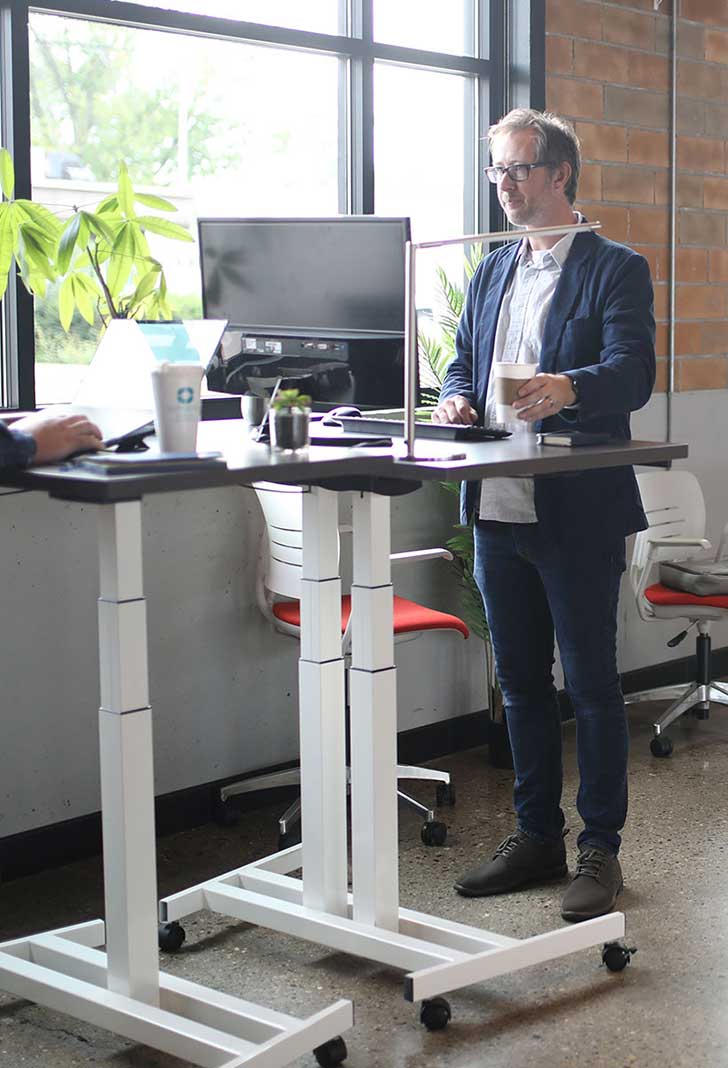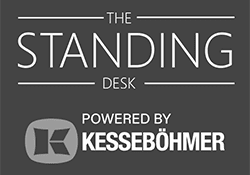What Is the Best Way to Stand at a Standing Desk?
A standing desk can be the healthiest addition to the office since the water cooler, but only if you’re using it the right way. How can you be sure you’re getting the most out of your standing desk and that it’s supporting your healthy lifestyle? Take a look at your standing desk habit and see if there are ways to tweak it to make your whole sit/stand workstation more ergonomic and active.
What Standing Desks Are Meant to Do
Most people who have a standing desk have chosen the sit/stand desk lifestyle for a reason. As you evaluate how you use a standing desk, keep in mind the reasons you want to use a standing desk as well. The most commonly cited standing desk benefits that people cite include:
- Reduce soreness and muscle pain: Too much time in a fixed posture can cause lower back, neck, and shoulder pain. Doctors report that many people experience posture-related problems from sitting like cervical lordosis, which can lead to bulging discs and a range of other musculoskeletal pains. By allowing the option to sit and stand at will, a standing desk can help reduce back pain by allowing more mobility and better posture.
- Improve focus at work: Staying in one position for a prolonged time can lead to a sluggish feeling at certain points in the day, which negatively affect your work and your quality of life. A height adjustable desk can help you return your focus to the task at hand, as long as the desk adjusts height as quickly as you do.
- Improve general feelings of wellbeing: According to one study, workers who sat for long stretches reported feeling more depressed and anxious than colleagues who sat less. Adjusting positions throughout the workday can affect general happiness.
- Help target cardiovascular health: For those concerned with their heart health, sedentary time has been shown to increase the risk of cardiovascular disease mortality. By using a standing desk, you can reduce sedentary time and stay on the right track.
- Slightly increase caloric burn: Since standing burns more calories than sitting, using a standing desk can affect the number of calories you burn in a day. The difference is modest, but small choices do add up over time, and a height adjustable desk are one part of an active lifestyle that encourages movement.
How Long to Stand at a Standing Desk
With a height-adjustable standing desk, the point isn’t just to stand in the healthiest way you can. You’ll also be sitting some of the time, adjusting your posture on a regular basis to make sure you’re getting the full benefit of the sit-stand desk.
In general, most studies suggest trying to stand for up to 2 hours a day at a standing desk, and then increasing from there as you are able. Find ways to develop the right mix of sitting and standing at a height adjustable desk. It may help to remember to stand when you’re doing certain tasks, like during regular phone meetings, or when you’re responding to email. Whether you’re sitting or standing, the important takeaway is to change postures whenever you become uncomfortable.
Your Best Standing Desk Posture
For the most ergonomic standing desk experience, you’ll need to adjust the desk so your head, shoulders, and hips are in alignment whenever you stand.
- Stand straight, engaging your abdominal muscles slightly.
- Bend your knees (again slightly) so you’re not hyperextended.
- Most importantly, strive to keep your elbows bent at a 90-degree angle, whether sitting or standing.
- Center your monitor slightly below eye level.
When you’re seated, your head, shoulders, and hips should be in alignment. Your thighs should be at a 90-degree angle to your spine.

Standing Desk Height
Make sure your desk is adjusted to the right standing desk height, whether you’re sitting or standing. If you’re tall or petite, you may need to find a desk that accommodates the range of height you need for proper standing desk height. The exact right desk height can vary between individuals who are the same height, because our bodies vary quite a bit in arm, leg, and torso length.
Standing Desk Accessories Make a Difference
Ergonomics involves more than just how you stand. It involves how you move as well. To make your standing desk experience more comfortable, consider adding accessories to support your correct posture. Standing desk accessories include things like:
- Standing desk mat to decrease impact on your joints
- Keyboard tray to set the keyboard height lower than the desk surface
- Laptop stand (if you use an external keyboard) or monitor arm (if you use an additional monitor) to adjust monitor height.
In addition to these accessories, a supportive, ergonomic chair or stool that allows movement can have a huge impact on your ability to maintain the correct posture while sitting.
-
Select options This product has multiple variants. The options may be chosen on the product page
-
Select options This product has multiple variants. The options may be chosen on the product page
-
Select options This product has multiple variants. The options may be chosen on the product page
-
Select options This product has multiple variants. The options may be chosen on the product page
How to Incorporate Movement at a Standing Desk
The best way to use a standing desk is neither sitting nor standing – it’s moving. What can you do to increase movement with a standing desk?
- Remember to walk around the workplace frequently, whether that means parking far from the office, taking a brief walk at lunch time, or taking the stairs to the water fountain on the next level.
- Take a standing desk exercise break every once in a while, without even leaving your desk.
- Add a treadmill beneath your standing desk.
- Fidget! Whether you move your feet or twirl your pen, studies show that many people gain focus by fidgeting, and one study indicated that fidgeting improves blood flow and arterial health.
- Use a balance board, a balance ball, or a motion stool like the Sthul. These items work well with a standing desk to improve balance and help you engage more muscles for active sitting or standing.
Whether you use a traditional office or home office standing desk, you’ll find an additional energy boost from incorporating a little more movement into your work day.
The Best Standing Desk for You
There is an ideal standing desk size, style, and adjustment mechanism that works best for each person, depending on your body and the way you work. Finding that best standing desk is the key to finding greater adjustability and flexibility. Start standing more, and moving more, with a height adjustable standing desk.







